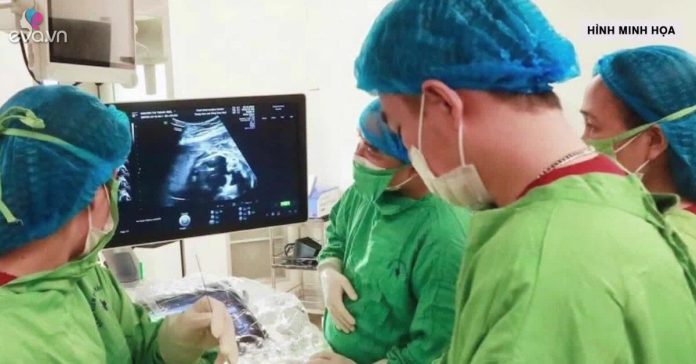Tóm tắt bằng tiếng Anh (800 từ)
Hanoi Obstetrics and Gynecology Hospital has recently performed a groundbreaking fetal intervention that successfully saved the life of a fetus at just 25 weeks gestational age. The unborn child faced a critical respiratory failure risk due to a severe pleural effusion, a condition where fluid accumulates in the pleural cavity, compromising lung development and function. This highly complex and rare case required advanced medical techniques and seamless interdisciplinary coordination to ensure a favorable outcome.
The case began when a 30-year-old pregnant woman, N.T.T. from Thanh Hoa Province, arrived at the hospital anxiously seeking medical care. Earlier, during a routine prenatal checkup at her local hospital at 22 weeks gestation, doctors discovered a significant right-side pleural effusion in the fetus. By the time she reached 25 weeks and 4 days, the situation had escalated significantly – the fetus was now facing lung compression and a high risk of pulmonary hypoplasia. The team of specialists at Hanoi Obstetrics and Gynecology Hospital determined that timely fetal intervention was critical to alleviate thoracic pressure and ensure the fetal lungs could develop properly.
Upon multidisciplinary consultation, the Fetal Intervention Center team at the hospital decided to perform an in-utero shunt placement, a delicate procedure aimed at draining the fluid from the fetus’s pleural space. Carried out under ultrasound guidance, a fine needle was carefully inserted through the mother’s abdominal wall and into the fetal pleural cavity. A tiny shunt was then placed, enabling continuous drainage of the pleural fluid into the amniotic sac. This procedure helped reduce intrathoracic pressure, allowing the fetal lungs to re-expand. At the same time, surplus amniotic fluid was removed to ensure a balanced intrauterine environment appropriate for the current gestational age.
Three days after the intervention, follow-up ultrasound showed promising results. The fluid build-up had significantly diminished, and the left lung was now free of effusion. The right lung had begun to expand well, and the fetal heart, previously pushed out of its normal position, had returned to the midline. Fluid in the abdominal cavity had resolved, and there was no longer any sign of polyhydramnios (excess amniotic fluid). The successful intervention provided the fetus with a much-improved chance of survival and healthy development.
This case serves as a powerful testament to the hospital’s capabilities in prenatal screening, precise diagnosis, and high-level fetal therapy. It is part of a broader system of care that includes early detection of congenital anomalies, expert consultations across different fields, and neonatal resuscitation planning. Particularly notable was the hospital’s collaboration with the Vietnam National Children’s Hospital, which was also instrumental in managing another complex perinatal case involving congenital heart defects.
In that separate instance, prenatal screenings identified a fetus with multiple rare congenital heart malformations—including a membranous ventricular septal defect, an overriding aorta, and severe pulmonary artery stenosis. These anomalies require complicated postnatal cardiac interventions. Given the critical nature of the findings, an inter-hospital consultation process was activated. Obstetricians, neonatologists, and imaging specialists from Hanoi Obstetrics and Gynecology Hospital teamed up with cardiac surgeons from the National Children’s Hospital to evaluate the fetus’s prognosis comprehensively. They developed an integrated delivery and postnatal care plan, culminating in the coordinated transfer of the newborn to the children’s hospital within just six hours after birth for specialized cardiac diagnosis and timely management.
Cases such as these vividly highlight the strength of Hanoi Obstetrics and Gynecology Hospital’s prenatal disease detection systems and inter-disciplinary coordination models. Equally crucial is their capacity for neonatal emergency response and optimized referral pathways, collectively enabling ‘golden hour’ interventions—those critical moments following birth when effective care has the most significant impact on survival and long-term health outcomes.
In addition to clinical excellence, the hospital has shown strategic foresight in fostering professional development and medical innovation. It regularly hosts scientific conferences for practitioners in the Hanoi region specializing in obstetrics and gynecology. These gatherings serve as venues where real-world case experiences are translated into up-to-date clinical knowledge, contributing to improved standards of care.
Cutting-edge obstetrical techniques have been successfully adopted and refined at the hospital, including amniotic cavity interventions and assisted reproductive technologies. The hospital is also a national leader in fetal medicine. Its annual Fetal Medicine Conference brings together both national and international experts, creating opportunities to exchange knowledge, strengthen guidelines, and keep pace with global trends in fetal healthcare. These efforts underscore the hospital’s vision of aligning Vietnam’s maternal and fetal medicine with the highest global standards.
In summary, the successful fetal intervention to treat severe pleural effusion at 25 weeks gestation, and the proactive perinatal management of a fetus with complex congenital heart disease, are shining examples of Hanoi Obstetrics and Gynecology Hospital’s dedication to innovation, precision, and collaborative care. With its integrated approach—spanning early diagnosis, advanced fetal therapy, inter-hospital collaboration, and comprehensive neonatal care—the hospital continues to provide high-quality treatment and hope for high-risk pregnancies. Its ongoing commitment to research, training, and international engagement ensures that Vietnamese mothers and their babies receive world-class care, even in the most challenging medical scenarios.


